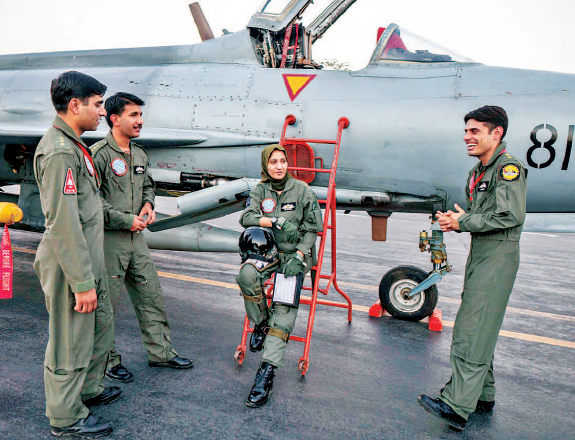

The picture shows a scene of the J-7PG fighter of the Pakistani Air Force
Sentry: J-7M fighter
In 1980s, the Chengdu Aircraft Manufacturing Factory launched the J-7M "Aerial sentry" model, which adopted the advanced electronic equipment from Britain's BAE and Marconi Company, and the MK10L ejection seat in its cockpit from the Martin Beeker Company.
The installation of new-type electronic equipment upgraded the firepower of the J-7M fighter, as it could carry the new-type Thunderbolt-7 model short-range air-to-air dogfight missile with an infrared homing seeker and higher mobility. In addition, the two newly added ammunition racks could allow it to carry more weapons.
Due to the load increase, the fighter was equipped with the new-type turbojet-5BM engine, high power generator and reinforced landing gears, and in addition, its airspeed head was moved to the right side in the front of fighter's body.
Jordan was the first to buy the J-7M fighters, but Jordan was not the end user of the J-7M fighters. These fighters were rapidly transferred to the Iraqi Air Force after staying at the bases in Amman and Mafraq of Jordan for a short time
It was interesting that the debut of the J-7M in the Iran-Iraq War also initiated Iran's strong interests, and as a result, Iran proposed to buy 36 J-7N fighters, a variant of J-7M, in 1987.
J-7P: An exclusive model for the Pakistani Air Force
After China exported the J-7M fighters to Pakistan in 1987, the Pakistani Air Force also ordered the new-type J-7P fighters which further complied with its requirements.
The J-7P fighter was equipped with four US-made AIM-9P sidewinder missiles, or four China-developed thunderbolt-5 or thunderbolt-7 missiles, and in addition, it can also carry additional three plug-in auxiliary fuel tanks.
The first batch of J-7P fighters were commissioned to the 20th Squadron of the Pakistani Air Force in July 1988 and deployed at the Rafiq base of Pakistan.
At the end of 1991, the Pakistani Air Force obtained additional 24 J-7P fighters. The chief of staff of the Pakistani Air Force stressed that "As the reliability of the J-7P fighters far exceeds that of the F-16 fighters, the J-7P fighters will not lose to the F-16 fighters in the future wars. As a kind of fighter, the J-7P fighters absolutely belongs to the first class fighters, said the chief of staff of the Pakistani Air Force."
In addition to the 20th Squadron of the Pakistani Air Force, the 25th Squadron of the Pakistani Air Force also obtained a batch of J-7P fighters. The base at which the 25th Squadron of the Pakistani Air Force was located was also scheduled to be expanded into an education center for specially training J-7P fighters. And at the same time, China and Pakistan will continue to discuss issues on upgrading J-7P fighter's airborne radar, added the chief of staff of the Pakistani Air Force.
In 1993, the two sides agreed to use the Griffin small-sized radars made by Italy's FIAR Company instead of the existing radars installed in the J-7P fighters.
In addition, as the Pakistani side was not satisfied with the ejection seats either, the two sides decided to adopt China independently developed IV-type seat which can eject the pilot out of the cockpit when the fighter was flying at the speed of 140 kilometers per hour and at the height of even zero meter above the ground.
PLA Air Force unveils jet fighters‘ stunning aerial images
2015-01-12Chinese Navy holds largest air combat drill with competitive fighters
2014-10-29Two new models of China’s fighters may debut in Zhuhai
2014-10-23J-10 fighters show aerobatic stunts in smog-free sky
2014-10-14J-11 fighters training in complex meteorological conditions
2014-05-16Copyright ©1999-2018
Chinanews.com. All rights reserved.
Reproduction in whole or in part without permission is prohibited.